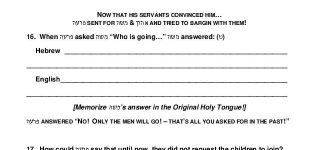Concrete Knowledge
The student will be able to demonstrate knowledge and retention of people, places, events/narratives, and select quotations.
2.01 People
B. Knows the names of secondary characters who interact significantly with main characters, and the roles that they play.
C. Identifies family relationships between main characters in the חומש being learned.
B. Knows the names of secondary characters who interact significantly with main characters, and the roles that they play.
C. Draws a family tree of main characters in the חומש being learned.
B. Knows the names of secondary characters who interact significantly with main characters, and the roles that they play.
C. Draws a family tree of main characters in the חומש being learned.
B. Knows the names and roles of a greater range of secondary characters (but not all), focusing on those who play a greater role in the main narrative of the חומש being learned, and retains knowledge of secondary characters from previous grades.
C. Draws a family tree showing relationships among main and secondary characters in the חומש being learned, including family trees from previous grades.
B. Knows the names and roles of a greater range of secondary characters (but not all), focusing on those who play a greater role in the main narrative of the חומש being learned, and retains knowledge of secondary characters from previous grades.
C. Draws a family tree showing relationships among main and secondary characters in the חומש being learned, including family trees from previous grades.
B. Knows the names and roles of a greater range of secondary characters (but not all), focusing on those who play a greater role in the main narrative of the חומש being learned, and retains knowledge of secondary characters from previous grades.
C. Draws a family tree showing relationships among main and secondary characters in the חומש being learned, including family trees from previous grades.
B. Knows the names and roles of most of the characters that appear in the חומש text and relevant מפרשים being learned, and retains knowledge of secondary characters from previous grades.
C. Draws a family tree showing relationships among main and secondary characters in the חומש text and relevant מפרשים being learned, including family trees from previous grades.
B. Knows the names and roles of most of the characters that appear in the חומש text and relevant מפרשים being learned, and retains knowledge of secondary characters from previous grades.
C. Draws a family tree showing relationships among main and secondary characters in the חומש text and relevant מפרשים being learned, including family trees from previous grades.
Grades 1-3: Knows the names and basic profiles (i.e. main characteristics provided in the text being learned) of the main characters in the text being learned.
Grades 4-6: Knows the names and profiles of the main characters being learned, including details provided by sources other than the חומש text (רש”י, מדרשים, מפרשים), and retains names and profiles from previous grades.
Grades 7-8: Constructs personality profiles of main characters in the text being learned, based on the חומש text and relevant מפרשים being learned,[8] and retains names and profiles from previous grades.
Grades 4-6: Knows the names and roles of a greater range of secondary characters (but not all), focusing on those who play a greater role in the main narrative of the חומש being learned, and retains knowledge of secondary characters from previous grades.
Grades 7-8: Knows the names and roles of most of the characters that appear in the חומש text and relevant מפרשים being learned, and retains knowledge of secondary characters from previous grades.
Grades 2-3: Draws a family tree of main characters in the חומש being learned.
Grades 4-6: Draws a family tree showing relationships among main and secondary characters in the חומש being learned, including family trees from previous grades.
Grades 7-8: Draws a family tree showing relationships among main and secondary characters in the חומש text and relevant מפרשים being learned, including family trees from previous grades.
[8] See Standard 4.09.
2.02 Places
B. N/A
B. Finds locations and traces routes on a map.
B. Finds locations and traces routes on a map.
B. Finds locations and traces routes on a map.
B. Can place major locations and trace significant routes on a map (i.e. ארץ ישרא-ל and מצרים, מדבר סיני, the ירדן).
B. Can place major locations and trace significant routes on a map (i.e. ארץ ישרא-ל and מצרים, מדבר סיני, the ירדן).
B. Can place major locations and trace significant routes on a map (i.e. ארץ ישרא-ל and מצרים, מדבר סיני, the ירדן).
B. Can place major locations and trace significant routes on a map (i.e. ארץ ישרא-ל and מצרים, מדבר סיני, the ירדן).
Grades 1-3: Knows the main places, referring to lands or nations, which are important to the story being learned (e.g. ארץ ישרא-ל, מצרים, ארץ פלישתים), and what took place in each.
Grades 4-8: Knows main places, referring to lands or nations, and more specific locations, i.e. cities, which are important to the story being learned (e.g. חברון, גרר, סוכות), and what took place in each, and retains knowledge of places from previous grades.
Grades 2-4: Finds locations and traces routes on a map.
Grades 5-8: Can place major locations and trace significant routes on a map (i.e. ארץ ישרא-ל and מצרים, מדבר סיני, the ירדן).
2.03 Events/Narratives
Grade 1: Knows the storyline (main events) of clearly cohesive stories learned in Chumash.
Grades 2-3: Knows the main events and significant details of the narrative that they are learning, and retains knowledge of storylines from previous grades.
Grades 4-8: Knows the broader storyline of multiple, connected stories in the Chumash that they are learning, and retains knowledge of storylines from previous grades.
2.04 Quotations – לשונות
Grades 2-3: Recalls and recites select key לשונות and expressions from פסוקים and content learned, and retains knowledge of quotations from previous grades.
Grades 4-8: Recalls and recites key לשונות, expressions, and important quotations from פסוקים and content learned, and retains knowledge of quotations from previous grades.


